In this article, you will learn how to create dynamic pricing strategies.
1. What is dynamic pricing
Dynamic pricing is a pricing strategy that adjusts prices in real-time based on various industry-specific factors such as:
- demand
- weather conditions
- peak and off-peak hours
- days of the week versus weekends
- time remaining before an event,
- and more.
The benefits of dynamic pricing
- Income maximisation: expected increase in income between 10 and 30%.
- Adaptation to demand fluctuations with real-time price changes
- Guaranteed early bookings as people tend to book 2x earlier with dynamic pricing. This helps to better anticipate event organisation and cash flow
- Increased online booking share by 10%. People are exposed to more complementary products in the booking flow, which increases revenue through cross-selling
- Improved online conversion rate
- Spreading demand over off-peak hours through encouraging prices, which can increase overall patronage by up to 10%.
- Increased customer satisfaction when they know they are getting a better price because they book in advance
2. Which dynamic pricing strategy to use
To familiarise yourself with dynamic pricing, our specialists have prepared 3 ready-to-use strategies that are already present in your Smeetz account. You can modify them without further ado to see how they have been configured and adapt them to your needs.
To access them, click on "Revenue Management" in the navigation bar of your account, then "Dynamic pricing".
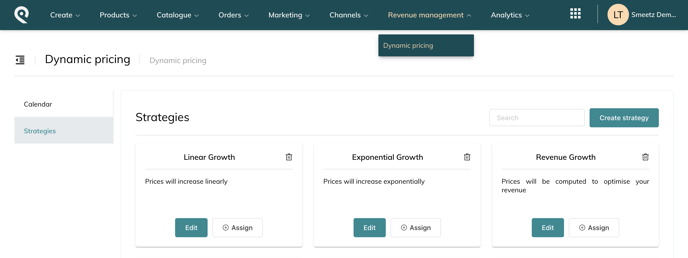
The three pre-existing strategies are the following:
- Linear Growth
- Exponential Growth
- Revenue Growth
If you are already familiar with dynamic pricing, you can create your own strategies from scratch.
3. How to create a custom dynamic pricing strategy
To get started, "create a strategy".
On the right, a new tab opens with the configuration of your strategy.
Step 1
The elements to be filled in in the 1st step are as follows:
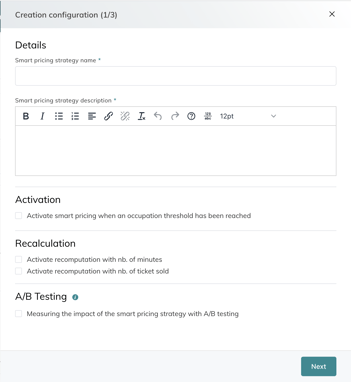
- Details: name and description of your strategy
- Activation: By checking this box, dynamic pricing will only be activated when a certain occupancy threshold has been reached.
The occupancy threshold is chosen as a percentage of the total number of tickets.
For example, if you choose a 10% occupancy threshold with a total quantity of 100 tickets; the smart-pricing strategy applies after selling 10 tickets.
- Recalculation: Here you choose when your price has to be recalculated, i.e. modified with a new amount. You can choose between two options:
- Define a number of minutes: the sales price will be recalculated every x minutes (e.g. every hour if you choose 60 minutes).
- Define a number of tickets sold: the sales price will be recalculated when x tickets are sold (e.g. every 50 tickets if you choose 50).
- A/B Testing: by ticking this box you are setting up an A/B testing strategy. This means that one group will be affected by dynamic price changes and another group will only see your base price which will remain static. With this control group, you can easily measure the impact of your smart pricing strategy on your customer base.
You choose the percentage of your sales to which you want to apply smart pricing.
For example, by choosing 80%, 80% of the customers who see your activity will be subject to dynamic pricing and 20% only see your normal.
Step 2
Then, you select your pricing model:
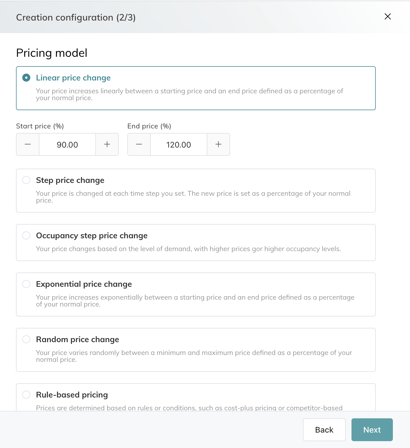
- Pricing model: The pricing method you choose is the most important element of your strategy. This will define how our algorithm will calculate your optimal prices. The 6 pricing models to choose from:
- Linear price change: your price will increase linearly between a starting price and an end price while the strategy is activated.
- You choose the start and end price as a percentage of your normal price.
- For example, if your starting price is 80% of your normal price and your final price 120% of your normal price, with a normal price of CHF 100, the price will increase linearly between CHF 80 and CHF 120.
- Step-price change: your price will vary at each step you set.
- This method is perfect if you are interested in selling several "packs" of tickets at different prices (e.g. early-bird tickets) based on the time of sale.
- Each time you add a step:
- you choose the selling price by indicating a percentage of the normal price.
- and you can choose whether or not to select how many days before the ticket date the smart pricing strategy is activated and how many days before the ticket date the smart pricing strategy is deactivated.

- Occupancy step-price change: your price changes based on the level of demand
- This method is perfect if you are interested in selling several "packs" of tickets at different prices based on occupancy levels.
- Each time you add a step:
- you choose the selling price by indicating a percentage of the normal price.
- and you can choose whether or not to select at what occupancy the smart pricing strategy is activated and at what occupancy the smart pricing strategy is deactivated.
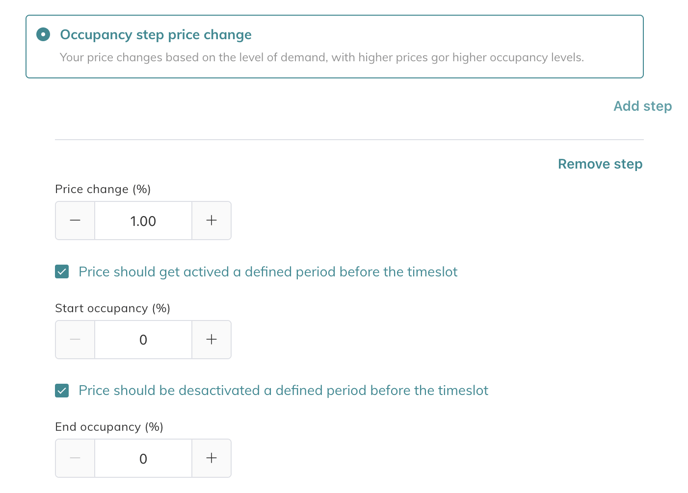
- Exponential price change: your price will increase exponentially between a starting price and an end price while the strategy is activated.
- You choose the start and end price as a percentage of your normal price.
- For example, if your starting price is 80% of your normal price and your final price 120% of your normal price, with a normal price of CHF 100, the price will increase exponentially between CHF 80 and CHF 120.

- Random price change: your price will vary completely randomly between a minimum and a maximum price.
- You choose the minimum and maximum price as a percentage of your normal price. The price thus varies randomly within the defined range.
- Rule-based pricing: your price will be calculated based on rule or conditions
- You can base it on the purchase date or the visit time
- Each time you add a step:
- ..........

- ..........
- Machine learning optimisation for more revenue: your price will vary with the objective of increasing your income by taking into account the number of tickets sold.
- You choose the minimum and maximum price as a percentage of your normal price. The price thus varies within the defined range.
- You can also choose to take other factors into account, such as:
- Weather forecasts: favourable weather forecasts => price increase
- Sales forecasts: increase in sales => price increase
- Web traffic forecasts: increase in web traffic => price increase
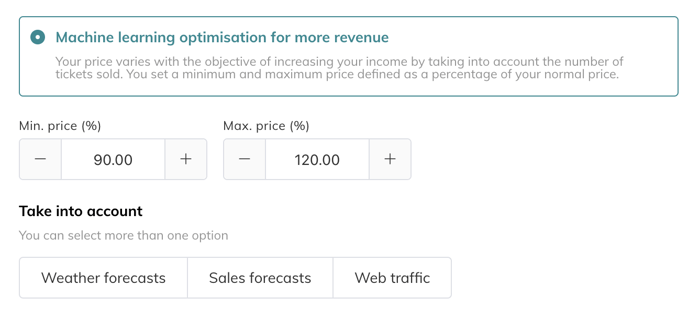
- Machine learning optimisation for more attendants: your price will vary with the objective of selling as many tickets as possible taking into account the flow of tickets sold.
- You choose the minimum and maximum price as a percentage of your normal price. The price thus varies within the defined range.
- You can also choose to take other factors into account, such as:
- Weather forecasts: favourable weather forecasts => price increase
- Sales forecasts: increase in sales => price increase
- Web traffic forecasts: increase in web traffic => price increase
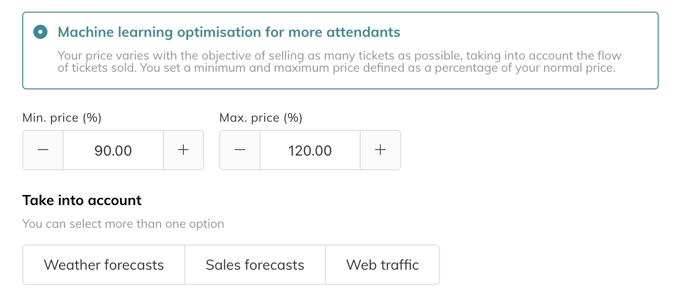
- Linear price change: your price will increase linearly between a starting price and an end price while the strategy is activated.
You can save your strategy at this point.
To link your pricing strategy to a ticket, go to this article: Link dynamic pricing strategies to your tickets
